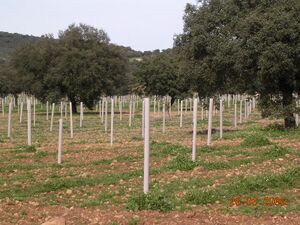Tree shelters
Animal browsing can be highly damaging to established vegetation, and nowadays browsing seedlings is a general problem in plantations of many biomes, where herbivores and rodents reach high densities. In this context, the risk of damage is so high that the increased cost of using protectors offsets the expected value of repeatedly replacing failed plants. Single tree shelters protect individual seedlings and saplings. For this reason, tree shelters have become a growing technology in forest restoration, since a positive global effect on plants, in addition to herbivory, has been observed [1].
Protection against herbivory: tree-shelters or fences?
Protectors act as a physical barrier that reduces animal damage, proving to be a resource almost as effective as fencing [2]. Additionally, fencing does not guarantee effectiveness in preventing the passage of small animals, and can be more expensive than using individual protectors. Fencing also restricts land use [3], or may have a negative impact on the landscape due to fragmentation. But fencing can be very effective against livestock or ungulates. The choose among fencing or single protection by tree-shelters is then site specific, and mast consider ecological issues, cost benefit analysis and predominant animal threat of the area.
Types of tree shelters
There are two groups of single protectors based on the material of their walls: shading nets (meshes) and plastic tubes with rigid walls (usually tubes). Both are effective against herbivory, although important differences in the micro-environment around the seedlings and in their effects on morphological response exist [4]. Along with the wall material, the height of the protector is crucial for its effectiveness. Protectors for rodents (rabbit, hare, etc.) usually do not exceed 0.6 m, while for ungulates, the height ranges between 1.2 and 2.1 m. Tubes must be ventilated through holes in their walls. This avoid CO2 deficiencies during maximum gas exchange activity [5] and/or the reduction of maximum temperatures in warm areas [6].
Additional beneficial effects of tree shelters. Tubes, meshes and effects on microclimate
In addition to herbivory, protectors have other protective effects against abiotic agents. This effect depends on environmental conditions, planted species, and the type of protector. Tubes modify the microclimate around the planted tree, causing changes in growth, resources allocation, etc., with consequences for establishment. The alteration of the microclimate is much more intense in the tubes than in the mesh. The former substantially modifies incident radiation, temperature, airspeed, pressure deficit, or CO2 concentration [7]; [8]. The mesh generally only reduces incident radiation. Since effectiveness is similar against herbivory, the choice between mesh or greenhouse will be conditioned by specific or environmental differences. Generally, in harsh restoration environments, tubes exert a favorable effect. Meta-analysis studies reveal that tree shelters improve survival overall, either in dry environments specifically [9]or on a wide world scale [10]. Besides, tree shelters provide protection against excess radiation. Tubes are preferred over meshes in harsh environment, and in areas with strong persistent winds, the tubes improve survival compared to mesh-protected plants [11]; [12]. On the contrary, meshes are preferred over tubes in temperate-humid environments or with early successional stress-resistant species such as Pinus spp [13],
- ↑ Abe, T. 2022. Effects of treeshelter on seedling performance: a meta-analysis. Journal of Forest Research 27(3): 171-181
- ↑ Thyroff, E.C.; Burney, O.T.; Oliet, J.A.; Redick, C.H.; Jacobs, D.F. 2022. Toward Identifying Alternatives to Fencing for Forest Restoration: Tube Shelters Outperform Mesh Shelters for Deer Browse Protection of Live Oak, Quercus virginiana. Land 11: 966
- ↑ Van Lerbherghe, P. 2014. Proteger los árboles contra los daños de la fauna cinegética. Los protectores de malla. Proyecto Pirinoble. Unión Europea. Institut pour le Développement Forestier. Paris. France. 35 pp.
- ↑ Devine, W.; Harrington, C.A. 2008. Influence of Four Tree Shelter Types on Microclimate and Seedling Performance of Oregon White Oak and Western Redcedar. Research Paper PNW-RP-576. USDA Forest Service. Pacific NorthWest Research Station. 54 pp.
- ↑ Bergez, J.E.; Dupraz, Z.C. 2000. Effect of ventilation on growth of Prunus avium seedlings grown in treeshelters. Agricultural and Forest Meteorology 104: 199-214.
- ↑ Puértolas, J.; Oliet, J.A.; Jacobs, D.F.; Benito, L.F.; Peñuelas, J.L. 2010. Is light the key factor for success of tube shelters in forest restoration plantings under Mediterranean climates? Forest Ecology and Management 260: 610-617.
- ↑ Oliet, J.; Navarro, R.; Contreras, O. 2003. Evaluación de la aplicación de mejoradores y tubos en repoblaciones forestales. Consejería de Medio Ambiente de la Junta de Andalucía. 234 pp.
- ↑ Bergez, J.E.; Dupraz, Z.C. 2009. Radiation and thermal microclimate in tree shelter. Agricultural and Forest Meteorology 149(1): 179-186.
- ↑ Piñeiro, J.; Maestre, F.T.; Bartolomé, L.; Valdecantos, A. 2013. Ecotechnology as a tool for restoring degraded drylands: a meta-analysis of field experiments. Ecological engeneering 61 (2013) 133– 144.
- ↑ Abe, T. 2022. Effects of treeshelter on seedling performance: a meta-analysis. Journal of Forest Research 27(3): 171-181
- ↑ Valenzuela, P.; Arellano, E.; Burger, J.; Pérez, M.A. Oliet, J.A. 2018. Soil conditions and sheltering techniques improve active restoration of degraded Nothofagus pumilio forest in Southern Patagonia. Forest Ecology and Management 424: 28-34
- ↑ Oliet, J.A.; Blasco, R.; Valenzuela, P.; Melero De Blas, M.; Puértolas, J. 2019. Should we use meshes or solid tube shelters when planting in Mediterranean semiarid environments? New Forests 50: 267-282.
- ↑ Oliet, J.A. Planelles, R.; Artero, F.; Jacobs, D.F. 2023. Mesh-shelters provide more effective long-term protection than tube-shelters or mulching for restoration of Pinus halepensis in a Mediterranean arid ecosystem. Front. For. Glob. Change 5:1092703


